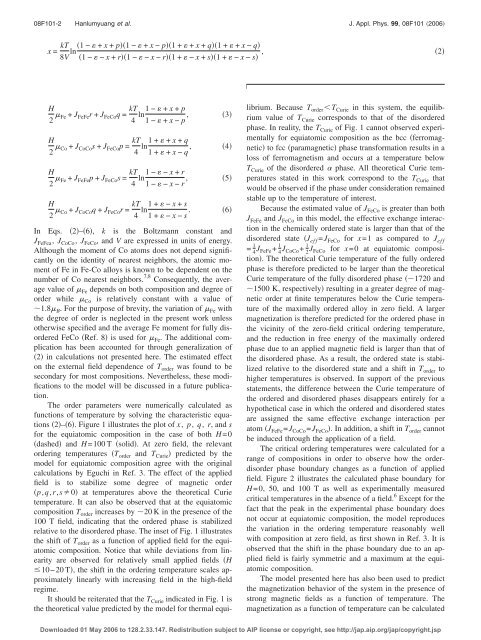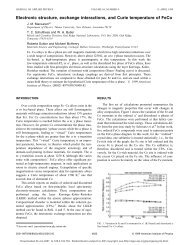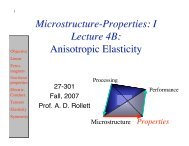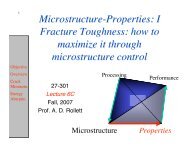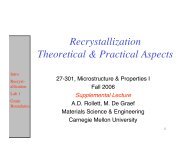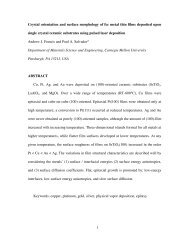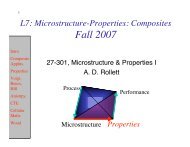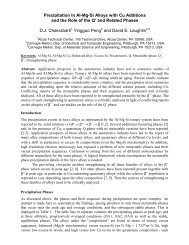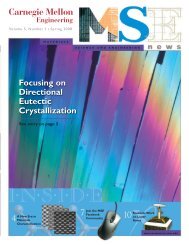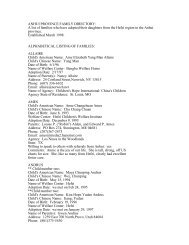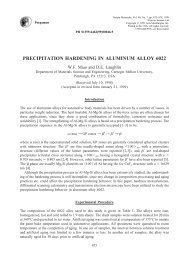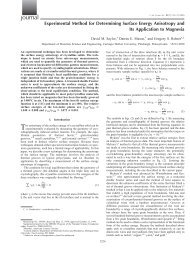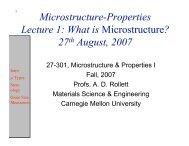Bragg-Williams model of Fe-Co order-disorder phase - ResearchGate
Bragg-Williams model of Fe-Co order-disorder phase - ResearchGate
Bragg-Williams model of Fe-Co order-disorder phase - ResearchGate
You also want an ePaper? Increase the reach of your titles
YUMPU automatically turns print PDFs into web optimized ePapers that Google loves.
08F101-2 Hanlumyuang et al. J. Appl. Phys. 99, 08F101 2006<br />
x = kT + x + p1− + x − p1+ + x + q1+ + x − q<br />
ln1− , 2<br />
8V 1− − x + r1− − x − r1+ − x + s1+ − x − s<br />
H<br />
2 <strong>Fe</strong> + J<strong>Fe</strong><strong>Fe</strong>r + J<strong>Fe</strong><strong>Co</strong>q = kT + x + p<br />
ln1− , 3<br />
4 1− + x − p<br />
H<br />
2 <strong>Co</strong> + J<strong>Co</strong><strong>Co</strong>s + J<strong>Fe</strong><strong>Co</strong>p = kT + x + q<br />
ln1+ , 4<br />
4 1+ + x − q<br />
H<br />
2 <strong>Fe</strong> + J<strong>Fe</strong><strong>Fe</strong>p + J<strong>Fe</strong><strong>Co</strong>s = kT − x + r<br />
ln1− , 5<br />
4 1− − x − r<br />
H<br />
2 <strong>Co</strong> + J<strong>Co</strong><strong>Co</strong>q + J<strong>Fe</strong><strong>Co</strong>r = kT − x + s<br />
ln1+ . 6<br />
4 1+ − x − s<br />
In Eqs. 2–6, k is the Boltzmann constant and<br />
J<strong>Fe</strong><strong>Fe</strong>a, J<strong>Co</strong><strong>Co</strong>, J<strong>Fe</strong><strong>Co</strong>, and V are expressed in units <strong>of</strong> energy.<br />
Although the moment <strong>of</strong> <strong>Co</strong> atoms does not depend significantly<br />
on the identity <strong>of</strong> nearest neighbors, the atomic moment<br />
<strong>of</strong> <strong>Fe</strong> in <strong>Fe</strong>-<strong>Co</strong> alloys is known to be dependent on the<br />
number <strong>of</strong> <strong>Co</strong> nearest neighbors. 7,8 <strong>Co</strong>nsequently, the average<br />
value <strong>of</strong> <strong>Fe</strong> depends on both composition and degree <strong>of</strong><br />
<strong>order</strong> while <strong>Co</strong> is relatively constant with a value <strong>of</strong><br />
1.8B. For the purpose <strong>of</strong> brevity, the variation <strong>of</strong> <strong>Fe</strong> with<br />
the degree <strong>of</strong> <strong>order</strong> is neglected in the present work unless<br />
otherwise specified and the average <strong>Fe</strong> moment for fully dis<strong>order</strong>ed<br />
<strong>Fe</strong><strong>Co</strong> Ref. 8 is used for <strong>Fe</strong>. The additional complication<br />
has been accounted for through generalization <strong>of</strong><br />
2 in calculations not presented here. The estimated effect<br />
on the external field dependence <strong>of</strong> T<strong>order</strong> was found to be<br />
secondary for most compositions. Nevertheless, these modifications<br />
to the <strong>model</strong> will be discussed in a future publication.<br />
The <strong>order</strong> parameters were numerically calculated as<br />
functions <strong>of</strong> temperature by solving the characteristic equations<br />
2–6. Figure 1 illustrates the plot <strong>of</strong> x, p, q, r, and s<br />
for the equiatomic composition in the case <strong>of</strong> both H=0<br />
dashed and H=100 T solid. At zero field, the relevant<br />
<strong>order</strong>ing temperatures T<strong>order</strong> and TCurie predicted by the<br />
<strong>model</strong> for equiatomic composition agree with the original<br />
calculations by Eguchi in Ref. 3. The effect <strong>of</strong> the applied<br />
field is to stabilize some degree <strong>of</strong> magnetic <strong>order</strong><br />
p,q,r,s0 at temperatures above the theoretical Curie<br />
temperature. It can also be observed that at the equiatomic<br />
composition T<strong>order</strong> increases by 20 K in the presence <strong>of</strong> the<br />
100 T field, indicating that the <strong>order</strong>ed <strong>phase</strong> is stabilized<br />
relative to the dis<strong>order</strong>ed <strong>phase</strong>. The inset <strong>of</strong> Fig. 1 illustrates<br />
the shift <strong>of</strong> T<strong>order</strong> as a function <strong>of</strong> applied field for the equiatomic<br />
composition. Notice that while deviations from linearity<br />
are observed for relatively small applied fields H<br />
10−20 T, the shift in the <strong>order</strong>ing temperature scales approximately<br />
linearly with increasing field in the high-field<br />
regime.<br />
It should be reiterated that the TCurie indicated in Fig. 1 is<br />
the theoretical value predicted by the <strong>model</strong> for thermal equi-<br />
librium. Because T <strong>order</strong>T Curie in this system, the equilibrium<br />
value <strong>of</strong> T Curie corresponds to that <strong>of</strong> the dis<strong>order</strong>ed<br />
<strong>phase</strong>. In reality, the T Curie <strong>of</strong> Fig. 1 cannot observed experimentally<br />
for equiatomic composition as the bcc ferromagnetic<br />
to fcc paramagnetic <strong>phase</strong> transformation results in a<br />
loss <strong>of</strong> ferromagnetism and occurs at a temperature below<br />
T Curie <strong>of</strong> the dis<strong>order</strong>ed <strong>phase</strong>. All theoretical Curie temperatures<br />
stated in this work correspond to the T Curie that<br />
would be observed if the <strong>phase</strong> under consideration remained<br />
stable up to the temperature <strong>of</strong> interest.<br />
Because the estimated value <strong>of</strong> J <strong>Fe</strong><strong>Co</strong> is greater than both<br />
J <strong>Fe</strong><strong>Fe</strong> and J <strong>Fe</strong><strong>Co</strong> in this <strong>model</strong>, the effective exchange interaction<br />
in the chemically <strong>order</strong>ed state is larger than that <strong>of</strong> the<br />
dis<strong>order</strong>ed state J eff=J <strong>Fe</strong><strong>Co</strong> for x=1 as compared to J eff<br />
= 1<br />
4J<strong>Fe</strong><strong>Fe</strong>+ 1<br />
4J<strong>Co</strong><strong>Co</strong>+ 1<br />
2J<strong>Fe</strong><strong>Co</strong> for x=0 at equiatomic composition.<br />
The theoretical Curie temperature <strong>of</strong> the fully <strong>order</strong>ed<br />
<strong>phase</strong> is therefore predicted to be larger than the theoretical<br />
Curie temperature <strong>of</strong> the fully dis<strong>order</strong>ed <strong>phase</strong> 1720 and<br />
1500 K, respectively resulting in a greater degree <strong>of</strong> magnetic<br />
<strong>order</strong> at finite temperatures below the Curie temperature<br />
<strong>of</strong> the maximally <strong>order</strong>ed alloy in zero field. A larger<br />
magnetization is therefore predicted for the <strong>order</strong>ed <strong>phase</strong> in<br />
the vicinity <strong>of</strong> the zero-field critical <strong>order</strong>ing temperature,<br />
and the reduction in free energy <strong>of</strong> the maximally <strong>order</strong>ed<br />
<strong>phase</strong> due to an applied magnetic field is larger than that <strong>of</strong><br />
the dis<strong>order</strong>ed <strong>phase</strong>. As a result, the <strong>order</strong>ed state is stabilized<br />
relative to the dis<strong>order</strong>ed state and a shift in T<strong>order</strong> to<br />
higher temperatures is observed. In support <strong>of</strong> the previous<br />
statements, the difference between the Curie temperature <strong>of</strong><br />
the <strong>order</strong>ed and dis<strong>order</strong>ed <strong>phase</strong>s disappears entirely for a<br />
hypothetical case in which the <strong>order</strong>ed and dis<strong>order</strong>ed states<br />
are assigned the same effective exchange interaction per<br />
atom J<strong>Fe</strong><strong>Fe</strong>=J <strong>Co</strong><strong>Co</strong>=J <strong>Fe</strong><strong>Co</strong>. In addition, a shift in T<strong>order</strong> cannot<br />
be induced through the application <strong>of</strong> a field.<br />
The critical <strong>order</strong>ing temperatures were calculated for a<br />
range <strong>of</strong> compositions in <strong>order</strong> to observe how the <strong>order</strong>dis<strong>order</strong><br />
<strong>phase</strong> boundary changes as a function <strong>of</strong> applied<br />
field. Figure 2 illustrates the calculated <strong>phase</strong> boundary for<br />
H=0, 50, and 100 T as well as experimentally measured<br />
critical temperatures in the absence <strong>of</strong> a field. 6 Except for the<br />
fact that the peak in the experimental <strong>phase</strong> boundary does<br />
not occur at equiatomic composition, the <strong>model</strong> reproduces<br />
the variation in the <strong>order</strong>ing temperature reasonably well<br />
with composition at zero field, as first shown in Ref. 3. It is<br />
observed that the shift in the <strong>phase</strong> boundary due to an applied<br />
field is fairly symmetric and a maximum at the equiatomic<br />
composition.<br />
The <strong>model</strong> presented here has also been used to predict<br />
the magnetization behavior <strong>of</strong> the system in the presence <strong>of</strong><br />
strong magnetic fields as a function <strong>of</strong> temperature. The<br />
magnetization as a function <strong>of</strong> temperature can be calculated<br />
Downloaded 01 May 2006 to 128.2.33.147. Redistribution subject to AIP license or copyright, see http://jap.aip.org/jap/copyright.jsp


